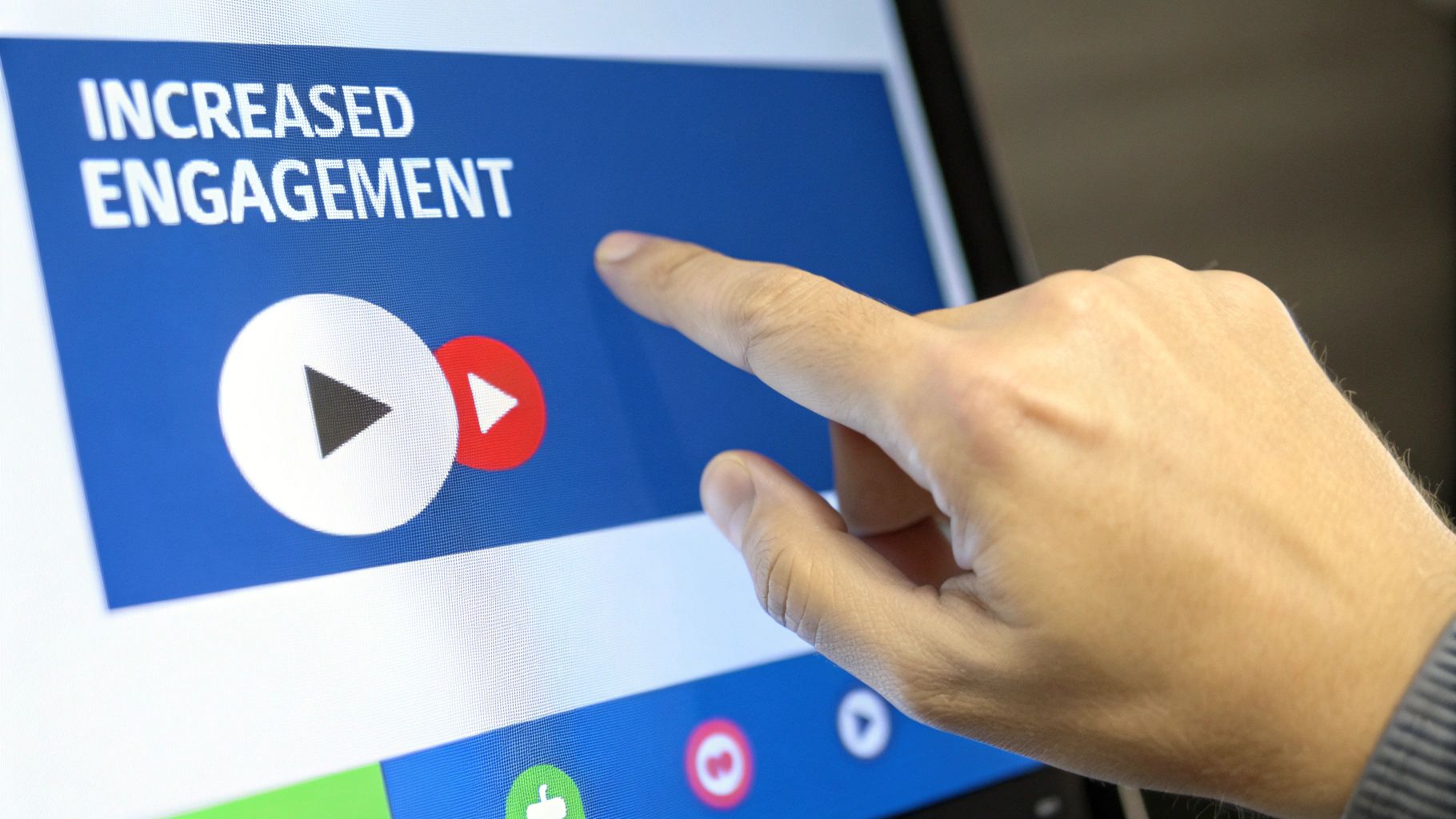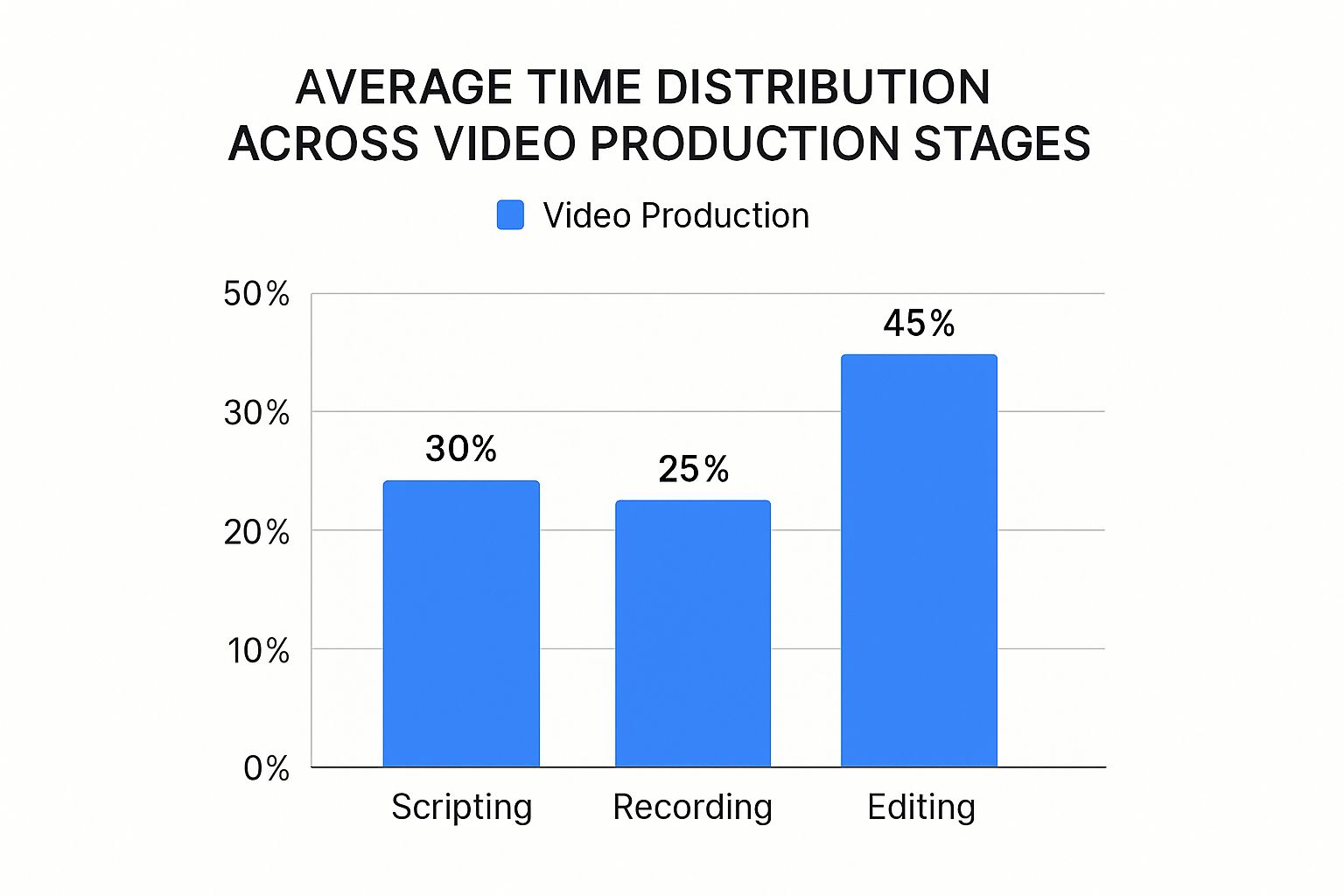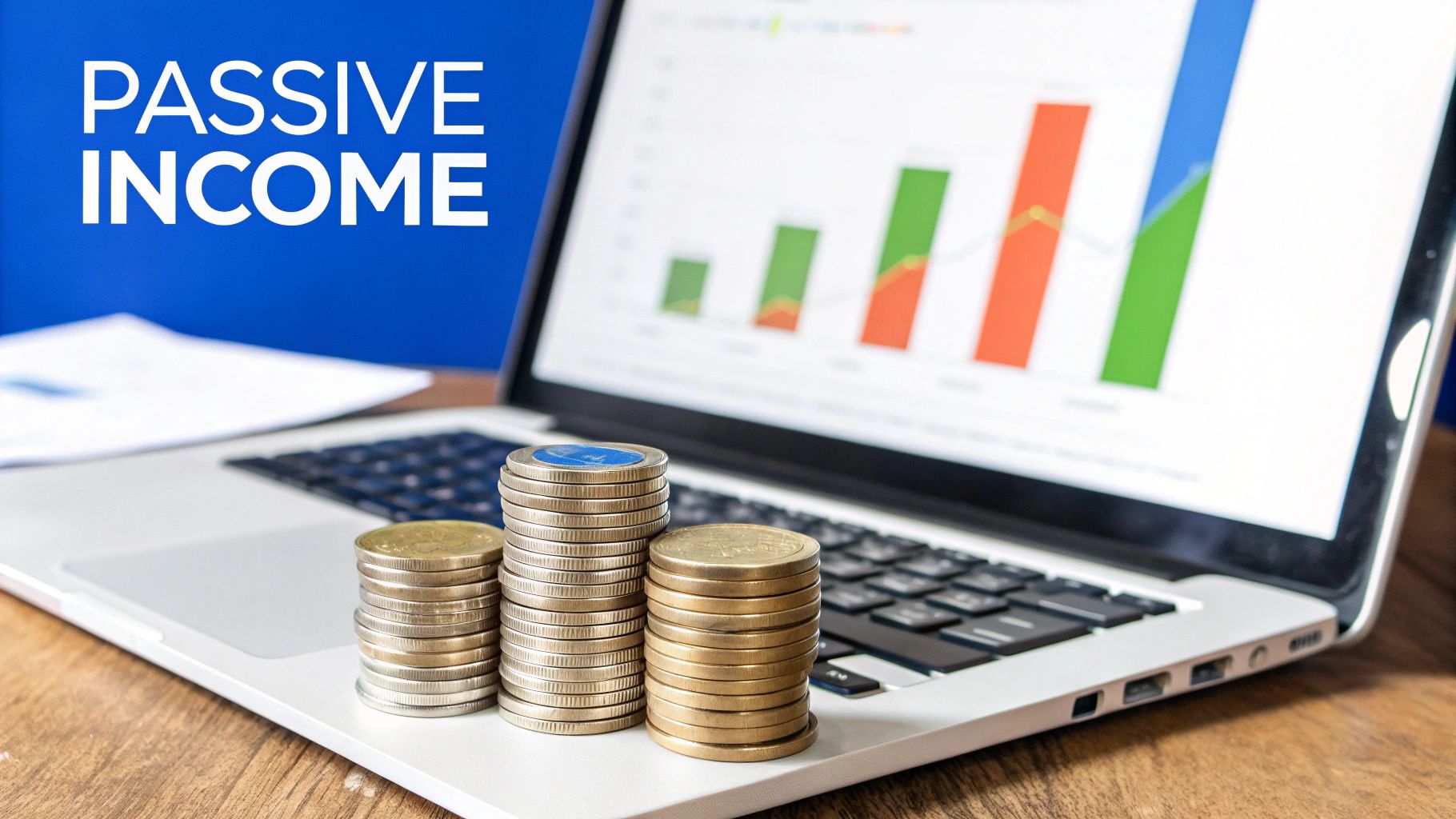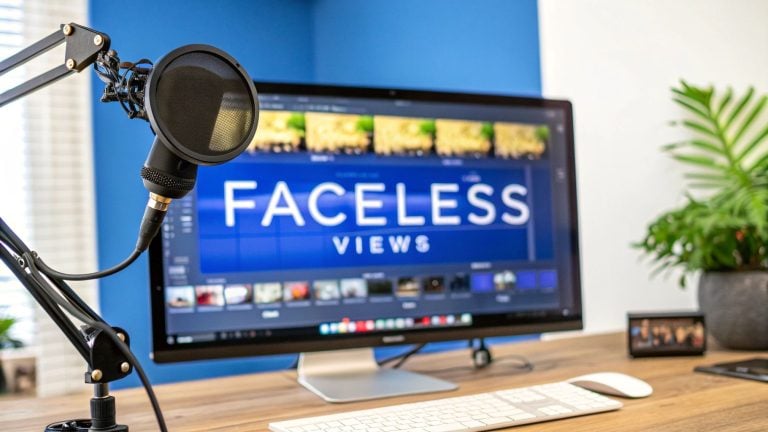You've probably seen them popping up everywhere: videos that rack up millions of views without ever showing the creator's face. These are faceless YouTube videos, a format where creators use voiceovers, stock footage, animations, or screen recordings instead of appearing on camera. This clever approach offers greater privacy and scalability, which is why so many creators are leaning into it.
Why Faceless YouTube Videos Are Absolutely Crushing It
The explosion of faceless YouTube videos isn't just some passing fad—it's a smart, strategic pivot in how content gets made. A ton of creators are intentionally staying off-camera, and it's about way more than just being shy. It’s a calculated decision that puts content quality and production speed ahead of personality-driven entertainment.
This model instantly kills the anxiety that comes with performing on camera. Forget about perfect lighting, what you're wearing, or how you're sitting. Instead, you can funnel all that energy into what actually matters: telling a great story, sharing valuable information, and making the final product as polished as possible.
The Power of Scale and Uninterrupted Focus
One of the biggest wins of a faceless channel is its potential to scale—massively. When you aren't physically required for every single video, the whole process transforms into a well-oiled machine that you can streamline, batch, and even hand off to others.
- Batch Like a Boss: You could write five scripts on a Monday, record all the voiceovers on Tuesday, and spend the rest of the week just piecing the visuals together. That kind of assembly-line efficiency is a pipe dream when every video needs a unique on-camera setup.
- Experiment Without Risk: A faceless format lets you test out different video styles, topics, and tones without confusing your audience. Your consistency is in your voice and the quality of your visuals, not your face.
- Build a Team: It’s way easier to bring on scriptwriters, voice actors, or video editors when you aren’t the bottleneck. This is how you go from a solo side hustle to a full-blown media company.
The big idea here is that a great story, clear instructions, or fascinating info can be way more powerful than a personality. People subscribe for the value you're giving them, not necessarily for who you are.
Building a Brand That's Bigger Than One Person
Ultimately, this whole approach proves you can build a powerful brand purely on the quality of your work. The recent surge in faceless channels is driven by creators who want to maintain their privacy while building a real, sustainable business online. This lines up perfectly with a growing desire for online anonymity and a way to sidestep the social judgment that can come with being a public figure. You can learn more about the rise of faceless channels on nexlev.io.
By taking yourself out of the spotlight, you create a content machine that can run without you. Your channel becomes a trusted resource, an entertainment hub, or an educational platform that stands on its own two feet. It’s proof that in the end, real value is what keeps an audience coming back for more.
Finding Your Niche and Planning for Success

Before you generate a single frame of video, the real work begins. The difference between a faceless channel that takes off and one that fizzles out is almost always a rock-solid plan. This early strategic thinking is what separates the pros from the amateurs.
A great faceless channel works because the content is the star, not the creator. While your voice and visual style will eventually become your signature, the topic itself has to be strong enough to draw people in on its own.
Identifying a Winning Niche
So, where do you start? Think about topics that are a natural fit for narration over visuals. We're talking about educational, explanatory, or even atmospheric content where the information or the mood is the main event.
Some niches are practically built for this format:
- Financial Explainers: Breaking down intimidating topics like crypto, stock market moves, or personal finance with clean animated charts is a huge win.
- Guided Meditations: This is a classic. A soothing voiceover paired with calming nature footage or abstract visuals creates an immersive escape for viewers.
- Animated Histories: People love a good story. Using simple animations and old footage can bring historical events to life in a way that’s far more engaging than a textbook.
- Tech Tutorials: Straight-to-the-point screen recordings that show people how to use software or fix a tech issue are always in demand.
If you need more inspiration, we've got a full guide on 10 profitable faceless YouTube channel ideas you can start today. It’s loaded with concepts that are perfect for this style.
Now, to really set your channel apart, you need to dig deeper and find niche keywords that hit a sweet spot with a specific audience. I highly recommend using a tool like TubeBuddy or VidIQ for this. They show you exactly what people are searching for, including the search volume and how tough the competition is. This data-driven approach means you’re not just guessing—you’re creating videos people are actively looking for.
Key Takeaway: Don’t just pick a niche you’re passionate about; validate it. Find topics with steady search interest but without a ton of competition. A smaller, highly engaged audience is way more valuable than a massive, indifferent one.
Building Your Content Roadmap
Once you've settled on a promising niche, it's time to get organized. A content calendar is non-negotiable if you want to stay consistent—something the YouTube algorithm absolutely loves. My advice? Brainstorm at least 10-15 video ideas before you even think about producing your first one.
Having this backlog is a lifesaver. It eliminates the weekly panic of "What am I going to post?!" and keeps you on track. You can organize these ideas in a simple spreadsheet or a tool like Trello.
For each idea, I suggest mapping out a few key details:
- Target Keyword: What's the main search term you're aiming for?
- Working Title: A catchy, keyword-focused headline.
- Quick Outline: A few bullet points on the main topics you'll cover.
- Status: A simple tracker like Idea, Scripting, Editing, or Published.
This kind of structure turns your channel from a casual hobby into a systemized operation. It gives you a clear direction and ensures a steady pipeline of content, which is exactly what you need to build momentum and keep your audience coming back.
Using AI to Write Scripts and Generate Visuals
With your niche locked in, it's time to tackle the two pillars of any faceless video: the script and the visuals. This is where AI really shines, turning what used to be a massive time-sink into a fast, creative workflow. The real trick isn't letting AI do everything, but using it as a partner to get your ideas off the ground and into production faster than ever.
A good script is the absolute soul of your video. When there's no face on screen for viewers to connect with, your words have to pull all the weight. The goal is a script that sounds like a natural conversation, not a robot reading an encyclopedia entry.
Crafting a Compelling AI-Assisted Script
Start by feeding a detailed prompt into a tool like ChatGPT or Jasper. Don't just ask for "a script about historical mysteries." That's too generic.
Instead, get specific. Tell it the exact topic, who you're talking to (your target audience), the vibe you're going for (suspenseful, educational, funny), and any key points you absolutely need to hit.
Once the AI spits out a first draft, your work begins. The most important thing you can do is read the script out loud. This is where you’ll catch all the awkward phrasing and sentences that drag on forever. A great script for faceless YouTube videos feels like someone is talking directly to the viewer. It needs to be clear, punchy, and flow smoothly from one idea to the next.
If you find your AI-generated scripts still sound a bit stiff, there are plenty of free tools to humanize AI text that can help you polish the final output. They’re great for smoothing out the robotic edges so your script truly connects with your audience.
Turning Words into Dynamic Visuals
Here’s where things get really exciting. Text-to-video AI platforms are a complete game-changer for faceless creators. A tool like Pictory is built specifically to take your finished script and automatically whip up a video sequence, pulling in relevant stock footage, images, and text overlays.
The process is surprisingly straightforward. You just paste your script into the platform. The AI then scans the text and starts hunting for matching visuals from its massive library of royalty-free media. This alone can save you hours of mind-numbing work searching for and downloading clips one by one.
As you can see, the entire workflow is designed around that script-to-video process, making it a perfect fit for this style of content.
Of course, what the AI gives you is a starting point, not the final product. You’ll definitely want to go through the clips it chose and swap out anything that doesn't quite match the mood or message of your narration. Think of it as a collaboration: the AI handles the grunt work, and you provide the final creative touch.
Pro Tip: Don't just accept the AI's first choices. Spend an extra ten minutes customizing the visuals. Swapping even a few key clips to better match the emotional tone of your script can make a huge difference in the final quality.
While these platforms have incredible libraries, sometimes you need something very specific. When that happens, here are a few of my go-to sources for high-quality, royalty-free assets:
- Pexels: An amazing resource for both free stock photos and videos.
- Pixabay: Another huge library of free-to-use content that rarely disappoints.
- Artlist & Epidemic Sound: These are subscription-based, but if you're serious about quality, the royalty-free music and sound effects they offer can seriously elevate your video's production value.
By combining an AI-polished script with an AI-generated video, you can create a powerful and efficient system for pumping out professional-grade faceless YouTube videos on a consistent schedule.
Recording Voiceovers and Assembling Your Video

You’ve got a polished script and a folder full of visuals. Now it's time for the fun part: bringing it all together with audio and editing. In a faceless video, your voice—or the one you choose—carries the entire show. It’s what builds trust and keeps people from clicking away, making it the place where your brand’s personality really comes through.
You’re looking at two main paths here: recording your own voiceover or using an AI voice generator. Both work great, but the right choice depends on your goals and how comfortable you are behind a mic. Just remember, terrible audio quality is one of the fastest ways to lose a viewer.
Your Voice or an AI Voice
There’s an authenticity that comes from recording your own voice that’s tough to replicate. You don't need a fancy studio to get it right, either. A solid USB microphone like a Blue Yeti or an Audio-Technica AT2020 will give you crisp, clean audio without breaking the bank. Just find a quiet room, speak clearly, and let your personality do the work.
On the flip side, AI voice generators from platforms like ElevenLabs or Speechify have gotten shockingly realistic. These tools are a lifesaver if you’re camera-shy (or mic-shy) or want to pump out content in different languages. They give you a huge range of tones and styles, so you can lock in a consistent audio brand without ever stepping up to a microphone.
No matter which route you take, nail these audio basics:
- Clarity: Make sure every word is easy to understand.
- Pacing: Find that sweet spot—not too fast, not too slow.
- Tone: Match your energy to the video’s vibe.
A flat, robotic delivery is a major turn-off, whether it's coming from you or an AI. You're aiming for a conversational, engaging tone, almost like you're talking to one person. That one-on-one feeling is what builds a real connection with your audience.
Assembling the Final Video
With your audio track ready to go, it’s time to jump into the editor. You don’t need to drop a ton of money on complicated software. User-friendly editors like CapCut (which works on both desktop and mobile) or DaVinci Resolve (which has a seriously powerful free version) are more than enough for creating great faceless YouTube videos.
The whole process is about weaving your voiceover, visuals, and maybe some music into a single, cohesive story. Start by dropping your voiceover track onto the timeline. Think of it as the backbone of your video; everything else will be built around it.
Next up, sync your AI visuals or stock footage with what’s being said. The images on screen should directly support the narration at that exact moment. This alignment is critical. If what people see doesn’t match what they hear, you’ll just confuse them. Our deep dive on how to create faceless video content has some more advanced tips on getting this sync just right.
Finally, add a subtle background music track to give your video a bit of emotional depth. Make sure you lower the volume so it complements the voiceover instead of fighting it. Sprinkling in some simple text overlays to call out key stats or phrases is another pro move that can seriously boost retention by making your video easier to scan and follow.
Optimizing and Monetizing Your Faceless Channel
So you’ve hit publish. That's a huge step, but the real work is just getting started. To turn your faceless YouTube channel from a hobby into a real business, you need a smart plan for getting your videos seen and, more importantly, getting paid.
This is where you need to start thinking like a marketer. YouTube is, after all, the second-biggest search engine on the planet. Your video’s title and description are your best friends here—they tell the algorithm exactly what your content is about. Load them up with keywords your ideal viewer is typing into the search bar. But don't forget the thumbnail; it’s basically your video's billboard and often the single biggest reason someone clicks.
Building Your Monetization Machine
Views are great, but you can't pay the bills with them. The goal is to turn those eyeballs into income. The first stop for most creators is the YouTube Partner Program (YPP), which is how you get a cut of the ad revenue. To get in, you'll need to hit 1,000 subscribers and rack up 4,000 hours of public watch time over the last 12 months.
But don’t just stop at ads. Honestly, the real money in the faceless content game often comes from stacking different revenue streams.
- Affiliate Marketing: This is a natural fit for faceless channels. You can drop affiliate links in your description for products or services you talk about in your videos. When someone buys through your link, you get a commission. No product creation, no inventory—just pure profit.
- Digital Products: Once you’ve built an audience that trusts you, selling your own digital goods is the next logical step. Think e-books, templates, checklists, or even full-blown online courses that go deeper into your niche.
- Sponsorships: As your channel gains traction, brands will start noticing. They might pay you to feature their products in your videos. This can be incredibly profitable, and brands often care more about your engaged audience than whether or not your face is on camera.
The earning potential here is no joke. Just look at giants like 5-Minute Crafts, which has pulled in around 81 million subscribers. Based on industry estimates, a channel that size could be generating upwards of $38 million a year. Even smaller, niche channels like The Fable Cottage, with its 826,000 subscribers, can bring in anywhere from $74,000 to $300,000 annually. The opportunity is massive.
Potential Monetization Paths for Faceless Channels
Building a solid income from a faceless channel means understanding all the avenues available to you. Each path has its own set of requirements and potential returns.
| Monetization Method | Requirements | Potential Income Level |
|---|---|---|
| YouTube Partner Program (YPP) | 1,000 subscribers & 4,000 watch hours | Low to High |
| Affiliate Marketing | An engaged audience, trust | Low to High |
| Sponsorships & Brand Deals | Consistent viewership, strong niche presence | Medium to Very High |
| Selling Digital Products | A loyal audience, proven expertise | Medium to Very High |
| Memberships/Patreon | A dedicated community willing to pay for extra content | Low to Medium |
| Merchandise | A strong brand and loyal fanbase | Low to Medium |
Ultimately, a mix-and-match approach is usually the most stable. Relying solely on ad revenue can be a rollercoaster, but layering in affiliate sales and sponsorships creates a much more resilient business.
A Glimpse into the Production Timeline
To get to monetization faster, you need to know where your time is going. This breakdown shows a pretty typical workflow for creating a faceless video from scratch.

As you can see, editing is usually the biggest time sink. That’s why dialing in an efficient workflow is absolutely critical if you want to scale up.
The most successful faceless creators don't rely on a single income source. They build a diversified monetization strategy where ad revenue is just one piece of a much larger, more stable financial puzzle.
To really blow up your channel’s reach and profitability, you need to think beyond YouTube. Exploring broader social media strategies for business success will help you drive traffic from other platforms and speed up your growth. For a deeper dive, check out our full guide on https://shortsninja.com/blog/how-to-earn-money-on-youtube-with-faceless-videos-2025/.
Common Questions About Building a Faceless Channel

Diving into the world of faceless content creation usually brings up a few big questions right away. Let's tackle them head-on, so you can move forward with a clear strategy and the confidence to get your channel off the ground.
One of the first hurdles for many creators is monetization. Can faceless YouTube videos actually make money? The answer is a resounding yes. As long as your channel hits the standard YouTube Partner Program milestones—that’s 1,000 subscribers and 4,000 watch hours—it’s fully eligible. The real key is delivering original value, whether that’s through unique commentary, slick editing, or a well-told story.
Can I Start with a Small Budget?
Another common worry is the gear. A lot of aspiring creators think they need a studio full of expensive equipment, but the reality is the barrier to entry is surprisingly low. Forget the high-end camera and professional lighting for now.
You can get a lot done with a simple, lean setup:
- A decent USB microphone: Audio is the one area you can't compromise on. Something like a Blue Yeti delivers crisp, clear sound without costing a fortune.
- Free editing software: You don't need to pay a subscription to get powerful tools. DaVinci Resolve offers professional-grade features completely free.
- AI and stock resources: Lean on AI video generators for your visuals and fill in the gaps with free stock libraries like Pexels.
Your most important investment isn't money; it's the time you pour into crafting a compelling script and developing a unique visual style. Your brand is built on your voice and the value you provide, not your face.
This stripped-down approach lets you focus your resources where they count, especially in the early days. By prioritizing great audio and storytelling, you can build a loyal audience that connects with the substance of your content, feeling your personality through your voice and engaging edits.
Ready to create compelling faceless videos in minutes? ShortsNinja uses AI to automate everything from scripting and visual generation to voiceovers and publishing.
Start your free trial and get a 30% lifetime discount with code NINJA30!

